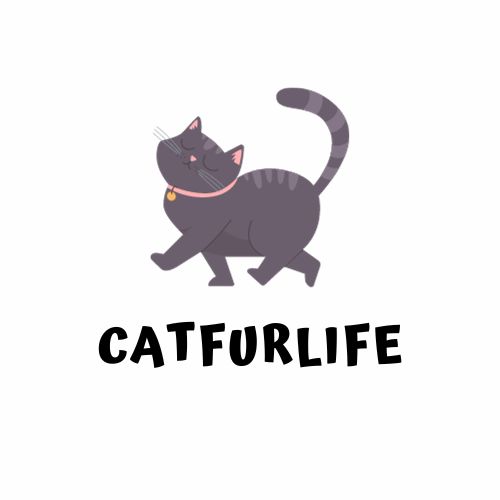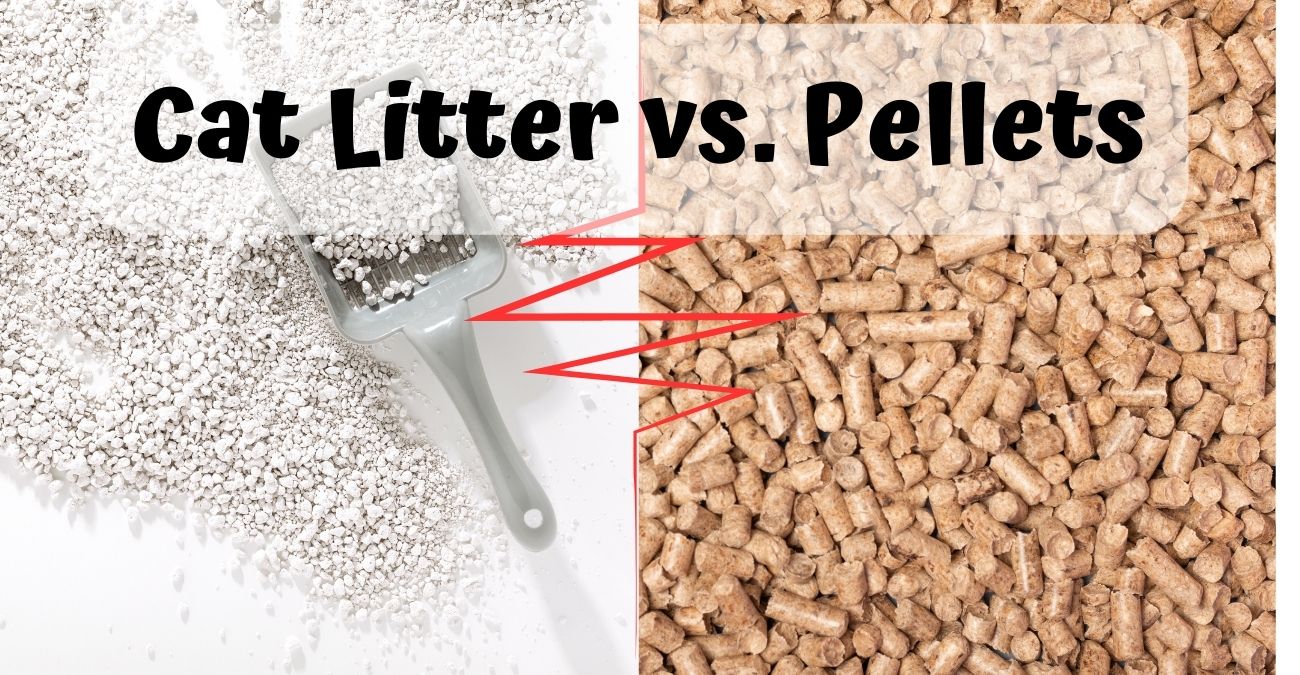Selecting the suitable litter for a cat’s litter box is a decision that requires careful consideration by pet owners.
Traditional cat litter, often made from clumping clay, has been widely used due to its high absorbency and odor-controlling properties.
However, in recent times, more environmentally conscious choices like biodegradable pellets have gained popularity.
These pellets, typically made from recycled paper, pine, or other natural materials, offer an eco-friendly alternative with different maintenance and waste management implications.
Cat Litter vs. Pellets
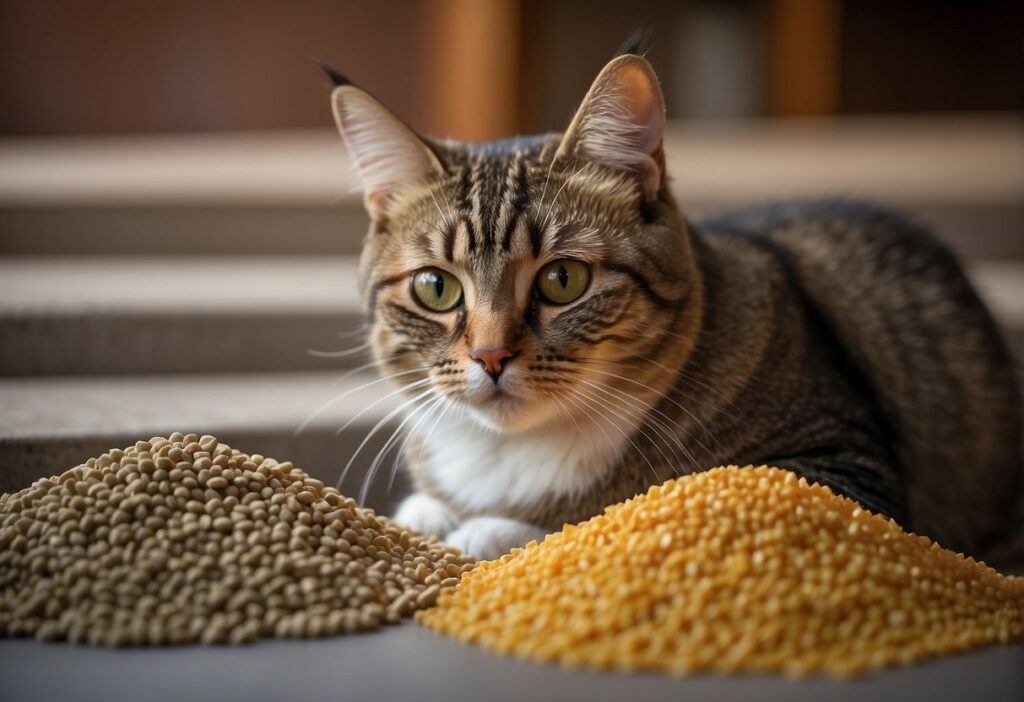
Both cat litter and pellets serve the fundamental purpose of providing a hygienic place for cats to relieve themselves.
While classic clay litter is known for its clumping action, which makes scooping out waste straightforward, there is often a concern about dust production and its impact on air quality in the home.
Conversely, pellets may produce minimal dust, but some cat owners do not control odors as effectively as clay litters nor clump in the same way, potentially complicating the cleaning process.
Cat owners must weigh the advantages and disadvantages of each option, considering factors such as absorbency, odor control, environmental impact, and compatibility with their cat’s preferences.
Whether prioritizing convenience, sustainability, or feline acceptance, choosing a product that aligns with the specific needs of both the cat and their owner is crucial.
Understanding Cat Litter Basics
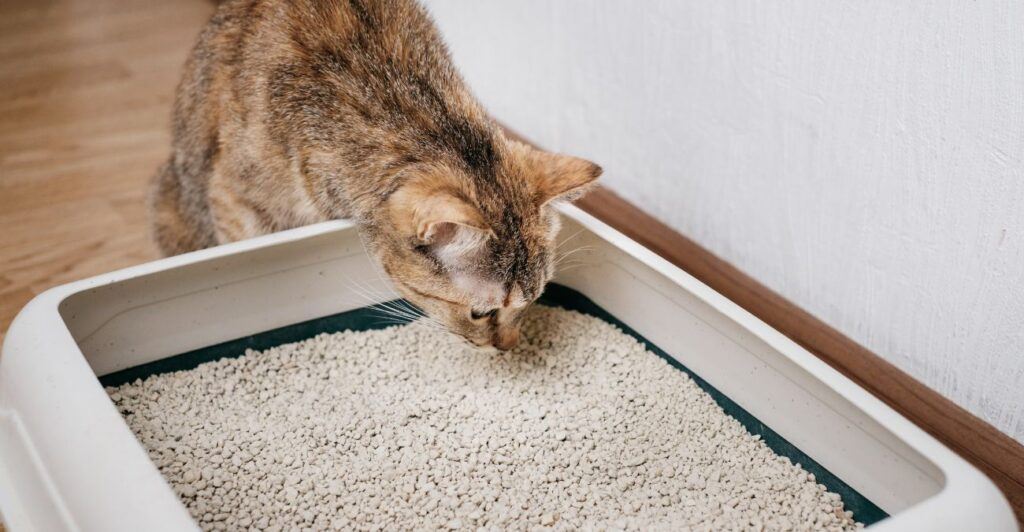
Selecting the right cat litter is crucial for the health and hygiene of house cats. Different types cater to various preferences and needs.
Types of Cat Litter
Cat litters are primarily classified by their main components. Traditional clay litter is widely used and consists mainly of bentonite, which clumps together when wet.
Silica gel or crystal litter is another popular type known for its extreme absorbency and odor control abilities.
Natural cat litter is made from various natural materials, including recycled paper, pine, wheat, corn, and walnut shells.
- Clay-based litter:
- Clumping: Forms solid clumps for easy removal.
- Non-clumping: Generally cheaper, absorbs waste without forming clumps.
- Silica gel litter:
- Consists of tiny, porous crystals for moisture and odor absorption.
- Natural cat litter:
- Utilizes renewable materials.
- Types of wood used can include pine, cedar, and other biodegradable options.
Benefits and Drawbacks of Traditional Clay Litter
Benefits:
- Highly absorbent: Clay litter is effective at soaking up cat urine.
- Odor control: Many clay litters are infused with additives that help control odor.
- Cost-effective: Generally less expensive than other types of litter.
Drawbacks:
- Dust: Clay litter can create dust, which may be an issue for cats and humans with respiratory problems.
- Environmental impact: Clay-based litter is not biodegradable and contributes to landfill waste.
- Weight: It is heavier than some alternative options, making it difficult to handle.
Exploring Wood Pellet Litter
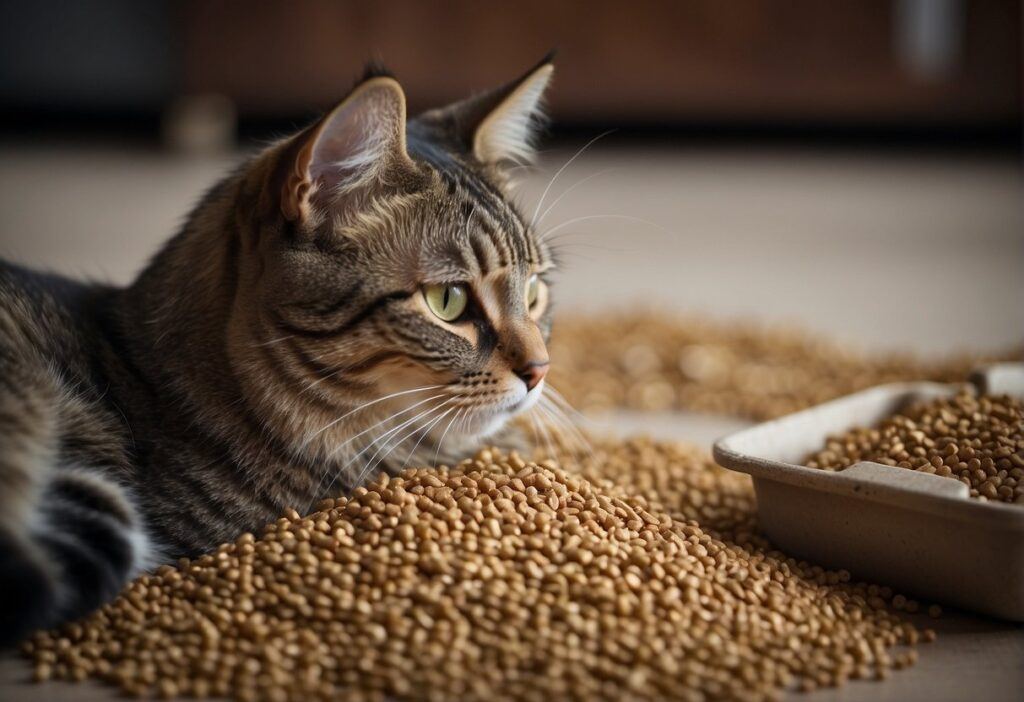
Wood pellet litter offers a natural alternative to traditional clumping litters, derived primarily from natural wood fibers.
The Composition of Wood Pellet Litter
Wood pellet litter is typically made from compressed natural wood fibers, often sourced from pine wood or other types of lumber industry by-products.
These wood fibers are subjected to high pressure to form dense, absorbent pellets.
Unlike conventional clay-based litters, wood pellet litters do not contain synthetic additives, making them a natural litter choice for cat owners.
Materials:
- Natural wood fiber: Primary component.
- Pine pellets: A common type of wood pellet made from pine.
- Binding agents: May be used to form the pellets.
Pros and Cons of Using Wood Pellet Litter
Pros:
- Eco-friendly: Derived from renewable resources, wood pellet cat litter is biodegradable.
- Odor Control: Natural resins in the pine pellets help neutralize odors without chemicals.
- Less Dust: Wood pellet litter produces less dust than clay litter, reducing respiratory irritants for cats and humans.
- Highly Absorbent: Wood fibers are naturally absorbent, helping to keep the litter box dry.
Cons:
- Non-clumping: Most wood pellet litters do not clump, making scooping waste less convenient.
- Weight: Wood litter can be heavier than traditional clay litter, potentially making handling and disposal more difficult.
- Cost: Depending on the brand, wood pellet litter can be more expensive than other types of litter.
- Tracking: While minimal, some pellets may break down and be tracked out of the litter box.
With its natural composition and significant environmental benefits, wood pellet cat litter presents a strong option for those seeking a sustainable choice.
However, considering the functional differences from traditional litters is key in determining its suitability for individual needs.
Comparing Absorbency and Odor Control
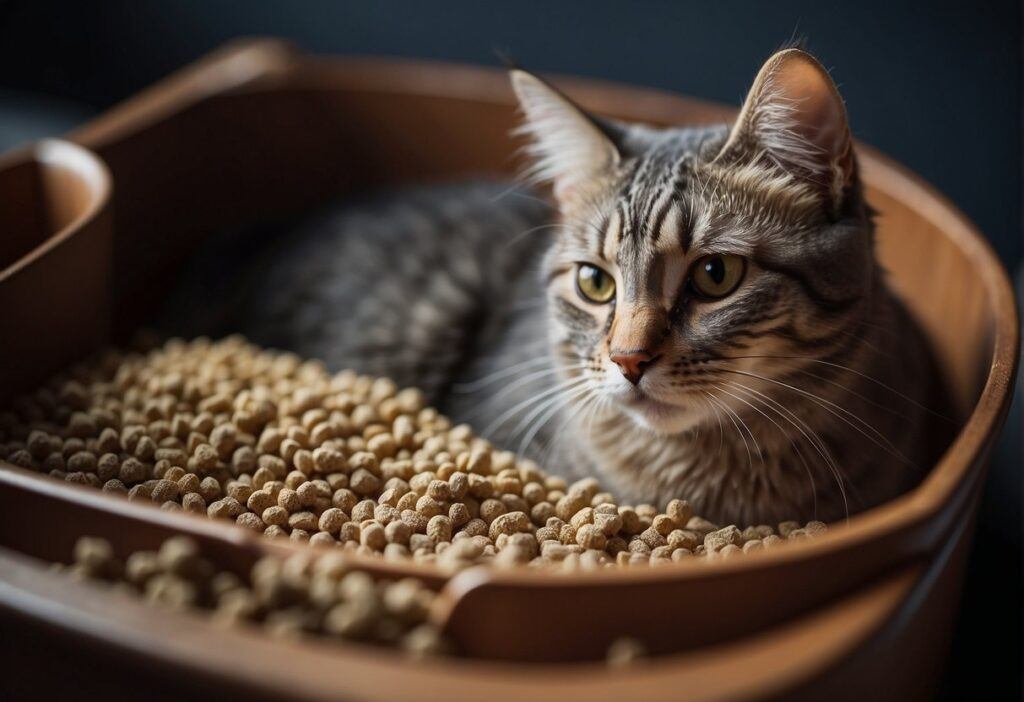
Effective cat litter should manage moisture from the cat’s urine and solid waste while controlling unpleasant odors.
This section will assess litter’s varying absorbency levels and odor control methods.
Absorbency Levels in Different Litters
Traditional clumping cat litter often contains sodium bentonite, which provides excellent absorbency due to its clumping properties.
It can absorb several times its weight in liquid, promptly isolating moisture from the cat’s urine. In contrast, non-clumping clay litter absorbs less liquid, resulting in more frequent changes needed.
Biodegradable litters, such as those made from recycled paper, wood, or corn, offer variant absorbency.
Paper pellets are less absorbent than clumping clay but effectively separate urine.
Wood and corn litters are known for their natural odor control and can be highly absorbent, although typically less so than clumping clay.
Methods of Odor Control
Clumping clay litters often include activated charcoal or baking soda to manage odors. These substances work by trapping the odors and reducing the presence of unpleasant smells.
Biodegradable options often rely on their materials’ natural scent and properties for odor control.
For instance, pine pellet litter neutralizes odors with its natural pine scent, while corn-based litter can control odor without adding artificial fragrances.
Biodegradable litters also tend to be low in dust, which helps maintain natural odor control by not unnecessarily perfuming the air.
A comparative table for quick reference:
| Litter Type | Absorbency | Odor Control |
|---|---|---|
| Clumping Clay | High | Activated Charcoal, Baking Soda |
| Non-Clumping Clay | Moderate | Less effective than clumping |
| Paper Pellets | Low to Moderate | Natural fibers, occasionally added fragrance |
| Wood Pellets | Moderate to High | Natural pine scent |
| Corn Based | Moderate to High | Natural scent, biodegradable properties |
Each type of litter comes with its own balance of absorbency and odor control effectiveness, and the choice may depend on a cat owner’s priorities for managing cat feces and urine.
Health Considerations for Cats and Owners
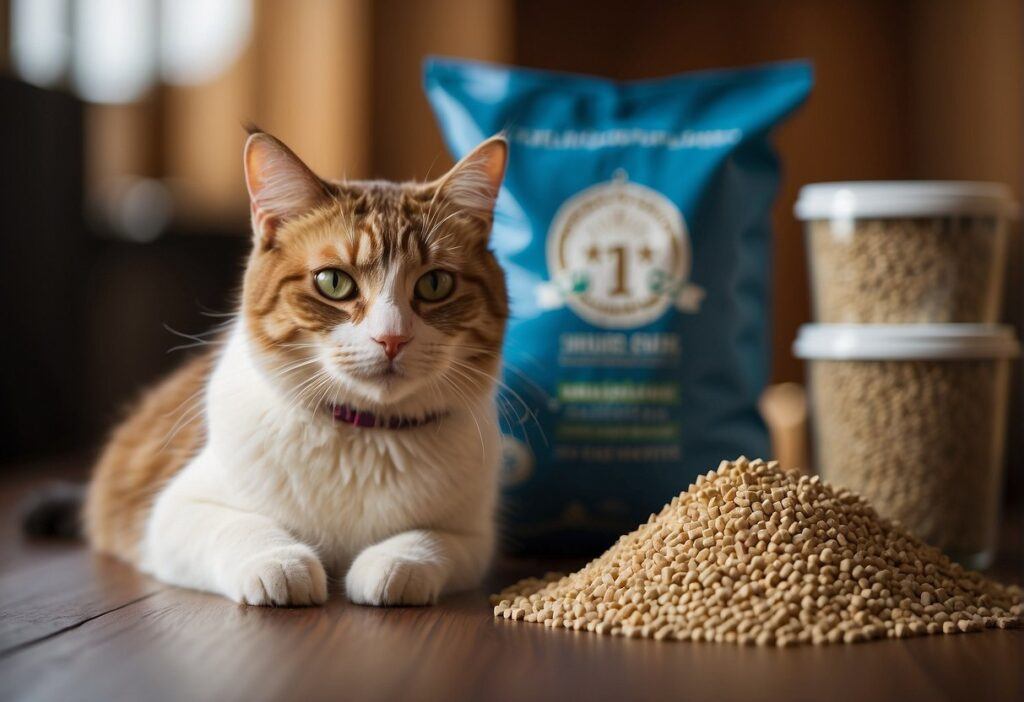
When selecting litter for their cats, owners should consider potential health implications for their pets and themselves, including allergies, respiratory issues, and the safety of litter ingredients.
Allergies and Respiratory Issues
Cats can develop allergic reactions or respiratory difficulties if they are sensitive to the dust from clay litter or fragrance additives. Inhalation of fine particles can cause:
- Sneezing
- Coughing
- Asthma-like symptoms
Owners, especially those with pre-existing respiratory conditions, should also be cautious as they can be affected by airborne litter dust.
In particular, pregnant women should avoid inhaling harmful substances that might be found in certain litters, as it could affect their health.
Safety Concerns with Litter Ingredients
Certain litters may contain elements that pose risks to cats and owners.
| Ingredient | Potential Risk |
|---|---|
| Synthetic Fragrances | Chemical sensitivities, skin irritations |
| Clumping Agents | Intestinal blockage if ingested |
| Silica Dust | Long-term exposure may affect the lungs |
For cats, continuous contact with litter can lead to skin irritations or harm their paws.
Choosing a litter that is gentle on a cat’s paws yet free of materials that may cause health issues upon ingestion or prolonged contact is essential.
Related: Cat Poop vs. Raccoon Poop
Environmental Impact and Sustainability
The sustainability of cat litter materials is critical, with significant environmental repercussions tied to their production and disposal.
This section evaluates the eco-friendliness of various litter types and scrutinizes the detrimental effects of their sourcing and creation.
Eco-Friendly Litter Choices
Natural Product Options: Consumers can now access various eco-friendly cat litter options at pet stores.
One natural product is tofu cat litter, made primarily from renewable resources.
It is biodegradable and typically contains natural ingredients like green tea, which helps to control odor naturally without using chemicals. Here is a concise comparison:
| Litter Type | Main Ingredient | Biodegradability | Renewable Source |
|---|---|---|---|
| Tofu Cat Litter | Tofu (Soybean) | Highly | Yes |
| Wood Pellets | Compressed Wood | Highly | Yes |
| Paper Pellets | Recycled Paper | Highly | Yes |
- Benefits: These litters decompose, reducing landfill waste. Renewable resources indicate lower environmental depletion.
- Disadvantages: The effectiveness of odor control and clumping can vary, influencing consumer preference and market demand.
The Problems with Mining and Manufacturing
Strip Mining Concerns: Traditional clay-based litter often involves strip mining for clay, which devastates ecosystems, alters landscapes, and contaminates water sources.
The manufacturing process further contributes to carbon emissions and energy consumption, complicating the environmental footprint.
Sustainability Challenges:
- Non-Renewable Resource: Once clay is extracted via strip mining, it cannot be replenished, posing a long-term resource issue.
- Energy Intensive Manufacturing: Converting raw clay into cat litter pellets requires significant energy, compounding its ecological impact.
Maintenance and Ease of Use
Maintaining a cat’s litter box influences the pet’s health and the home’s cleanliness. Proper management ensures a hygienic environment while simplifying the cleaning process for cat owners.
Cleaning and Replacing Your Litter
When choosing cat litter, one should consider how often they’re willing to clean the box.
Traditional cat litter requires scooping out clumps and solid waste daily, with a complete change of the litter recommended every week or two.
Over time, the buildup of waste at the bottom of the box makes thorough cleaning essential, necessitating the removal of used litter and scrubbing of the box.
Pellets, on the other hand, offer a different approach. They tend to absorb urine, breaking it down into sawdust, which can be sifted from solid waste.
However, if not sifted regularly, the sawdust can accumulate and may require more frequent replacement of the entire contents of the litter box to prevent odors.
With pellets, owners generally spend less time on daily maintenance but should still ensure the bottom of the litter box is clean to maintain a hygienic space for their cat.
- Traditional Litter Maintenance:
- Daily scooping of clumps and solids.
- Complete replacement of litter every 1-2 weeks.
- Regular scrubbing of the litter box is required.
- Pellet Litter Maintenance:
- Daily sifting may be required to remove sawdust.
- Less frequent total replacement, depending on usage.
- May involve less overall time spent on daily cleaning.
Selecting a Litter Box
The selection of a litter box can impact the ease of maintenance significantly. For traditional cat litter, a box with higher sides helps contain litter within the box during use.
A box with a smooth interior surface will ease the cleaning process, making removing stuck litter from the bottom of the litter box easier.
In contrast, using pellets often calls for a litter box with a specialized sifting system to separate the sawdust from the solid waste.
Some litter boxes are designed with a secondary bottom tray that catches the sawdust, allowing for easy disposal without replacing the new litter as frequently.
- Traditional Litter Box Features:
- High sides to prevent litter scatter.
- Smooth interior for easier cleaning.
- Pellet Litter Box Features:
- Sifting system to separate waste from sawdust.
- Dual-tray design for convenient sawdust disposal.
Incorporating the right litter and box combination can streamline the cleaning process and ensure better hygiene for your cat’s litter box.
Cost Considerations for Cat Owners
When choosing between cat litter and pellets, owners should consider initial price, longevity, and any additional expenses involved in maintenance.
Finding Cost-Effective Litter Options
Owners looking for the best cat litter value should compare the upfront costs of litter and pellets.
Generally, clay-based litters are more cost-effective upfront due to their lower price per pound. In contrast, biodegradable pellets are pricier initially but may last longer before needing replacement.
- Clay Litter (per pound): $0.50 – $1.50
- Biodegradable Pellets (per pound): $1.00 – $2.00
Long-Term Costs of Litter Ownership
In the long term, the right litter can reduce the frequency of changes. Low dust options may prevent respiratory issues, potentially avoiding vet bills due to cat allergy or asthma-like symptoms.
- Clay Litter:
- Needs frequent replacement
- Higher maintenance due to tracking
- Pellets:
- Lower dust, resulting in less cleanup
- May need replacement less often, thus saving on small amounts purchased frequently
Owners should also consider the extra cost of specialty litters that are marketed as low dust or have added odor control.
Despite the higher price tag, these products may save them money and effort over time. The best choice will depend on balancing the initial cost and the benefits over a long period.
Selecting the Right Litter for Your Cat
Choosing the appropriate litter is vital for a cat’s health and a pet owner’s convenience.
This section provides an overview of recognizing cat preferences and the most notable litter types available, aiding in an informed decision.
Assessing Your Cat’s Needs and Preferences
Cats have individual preferences and needs when it comes to their litter. Observing the cat’s behavior is essential in identifying those needs.
Some cats may have sensitivities and be irritated by heavily scented litter, while others may prefer a finer texture.
A cat’s age and health should be considered—kittens and older cats might need softer, more absorbent litter for delicate paws. For those susceptible to respiratory issues, dust-free options might be crucial.
Litter Factors to Consider:
- Texture: Fine, coarse, or pellet-shaped
- Odor Control: Carbon-infused, scented, or natural odor absorbers
- Dust Production: High dust, low dust, or dust-free
- Absorbency: How quickly it soaks up moisture
- Tracking: The tendency to stick to paws and spread outside the box
- Eco-friendliness: Biodegradable and sustainably sourced materials
The Most Popular Litter Options Reviewed
The market offers various types of cat litter, each with advantages and drawbacks that can cater to different needs.
Clumping Litter:
Often made of bentonite clay, clumping litter permits easy removal of waste.
Major clay brands offer options ranging from budget-friendly to premium varieties, with added features like multi-cat formulas or enhanced odor control.
Pine Pellet Litters:
Wood pellet cat litter, such as Feline Pine, provides a natural, eco-friendly choice. Pine pellet litters are known for their superior odor control and minimal dust production. Their larger size reduces tracking significantly.
Comparison Table:
| Feature | Clumping Litter | Pine Pellet Litter |
|---|---|---|
| Texture | Fine granules | Pellet-shaped |
| Odor Control | High (with additives) | High (natural pine scent) |
| Dust | Varies (low to high) | Low to none |
| Absorbency | High | Moderate to high |
| Tracking | Moderate to high | Low |
| Eco-friendly | Varies | High (biodegradable) |
When deciding on the best choice of litter, consider the specific needs and habits of the feline friends.
It’s important not to compromise the health or comfort of the cat while also keeping the maintenance preferences of the cat owner in mind.
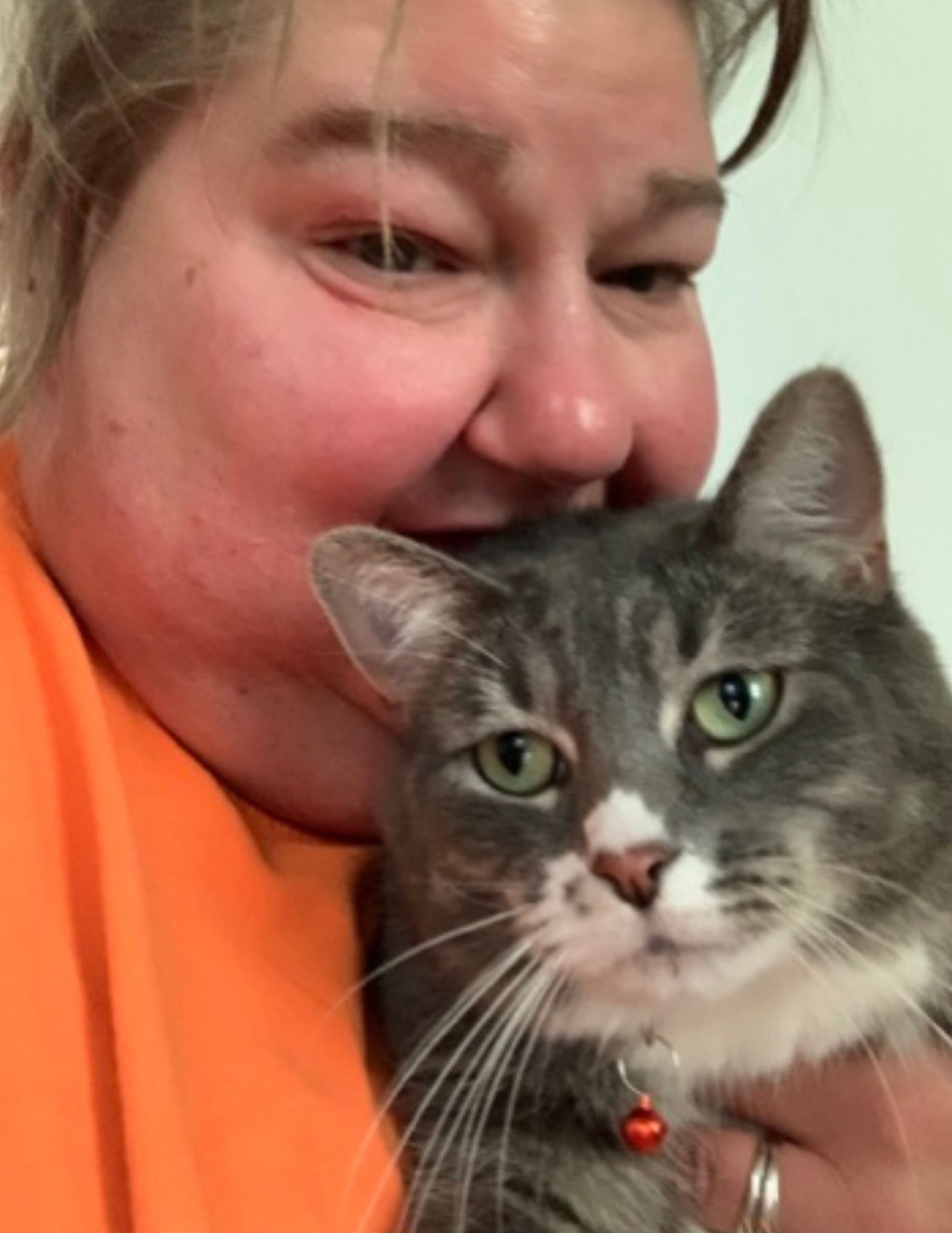
Meet Ann Haasnoot, the passionate founder of CatFurLife.com. A lifelong cat lover from Wisconsin, Ann combines her extensive feline behavior and care knowledge with her love for writing. On her website, she shares invaluable insights about cat breeds, care tips, and her experiences with her beloved furbaby, aiming to deepen the bond between cats and their human companions.
